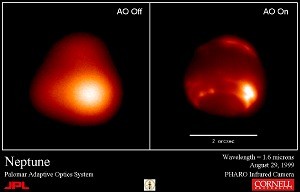Some of best Earth-bound images yet of distant planet Neptune captured by Cornell-designed camera on Palomar telescope
By David Brand
The heavens are sharper than ever before to the Earth-bound watcher, thanks to astronomers at Cornell University and NASA's Jet Propulsion Laboratory (JPL). Cornell researchers have built an infrared camera for the California Institute of Technology's 200-inch Hale telescope at Palomar Observatory on the summit of California's Palomar Mountain that is providing detailed images unobstructed by atmospheric turbulence.
The camera, the Palomar High Angular Resolution Observer (PHARO), receives light from a new adaptive optics (AO) system that corrects the turbulence to produce images with detail near the theoretical limit of the telescope. The camera was designed and built by a Cornell team led by engineers Thomas Hayward and Bernhard Brandl. The AO system was developed by a JPL team led by Richard Dekany. JPL is a division of Caltech.
In the first attempt to do new science with the new Hale system, Cornell astronomer Don Banfield worked with the Cornell and JPL instrument teams this August to produce near-infrared images and spectra of Neptune, the eighth planet from the sun.
Neptune is a mostly gaseous planet, and only the upper layers of its atmosphere are visible. The planet is so distant that normally it is impossible to detect fine detail with terrestrial telescopes. The new images show the planet embellished with a massive cloud, the size of the European continent, and numerous smaller clouds. The astronomers also took high-spatial-resolution spectra of the atmospheric features. "This is the only instrument currently available that provides both the high spatial resolution of an adaptive optics system and, at the same time, spectral information," says Banfield.
From the data obtained by PHARO's spectrometer, according to Banfield, it will be possible to do a detailed analysis of the planet's clouds and their altitude. "We can also measure the abundance of methane in the atmosphere. Because of the excellent spatial resolution, we can determine the physical properties of individual cloud features and eventually learn something about the planet's atmospheric circulation," says Banfield. A spectrometer is a device that splits electromagnetic radiation, in this case infrared light, into a spectrum of frequencies, or colors.
Neptune, which is a bit less than four times the radius of the Earth, was chosen as the first major object for imaging, says Hayward, because the AO system requires a small source to lock on to so that it can correct the effects of the atmosphere. "Neptune's disk is small and bright enough for the system to lock on."
Both Cornell and JPL use the Hale telescope under an agreement with Caltech, which owns the facility. Cornell astronomers use one-fourth of the total observing time at Palomar to pursue their work in infrared and optical astronomy. Each member institution of the consortium contributes funding and builds instruments to keep the telescope running as a state-of-the-art facility.
In 1995 JPL began work on the new AO system, basically a mirror placed between the telescope and camera and which is adjusted up to 500 times a second to correct atmospheric distortions. The Cornell researchers, taking advantage of their detector and infrared instrumentation experience, developed a new camera to take advantage of the AO's high-resolution images.
Hayward believes that the latest optics on the Hale telescope are competitive with any telescope in the world, and even the orbiting Hubble Space Telescope, for the clarity of images. "PHARO is a more flexible camera than other AO systems have had in the past. Plus, because Cornell has 90 nights a year on the Hale, we can do long-term projects such as looking at objects over and over again to search for changes," says Brandl.
The next object to be studied using the new Hale system will be Titan, the largest of Saturn's 18 known satellites, in a research collaboration led by Michael E. Brown of Caltech. Hayward notes that the late Carl Sagan, who was the David Duncan Professor of Astronomy and Space Sciences at Cornell, had intended to observe Titan using the Hale telescope. "We'll all be thinking of Carl while we are doing it, " Hayward says.
Funding of about $1 million for the development of PHARO came from the Norris Foundation, the National Science Foundation and Cornell. Other members of the Cornell team were James Houck, the Kenneth A. Wallace Professor of Astronomy; Craig Blacken, George Gull and Bruce Pirger, research support specialists; and Justin Schoenwald, senior programmer/analyst.
Media Contact
Get Cornell news delivered right to your inbox.
Subscribe